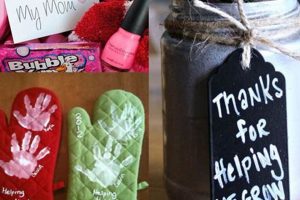The creation of personalized holiday illuminations, crafted within a domestic setting using readily available materials, embodies a festive activity. These handmade light sources frequently incorporate wax, wicks, and decorative elements tailored to individual preferences. For instance, the repurposing of old jars filled with scented wax and embellished with seasonal botanicals exemplifies this practice.
Handcrafted holiday lighting offers numerous advantages, including cost-effectiveness and creative expression. The activity promotes resourcefulness and allows for the creation of unique, personalized gifts or home decorations. Historically, the making of festive lights represents a connection to traditional holiday customs, offering a tangible link to past celebrations and a move away from mass-produced items.
This exposition will further explore various methods for constructing these personalized festive lights, detailing material selection, safety considerations, and decorative techniques. The following sections will provide step-by-step instructions and inspiration for crafting a range of holiday-themed illuminations.
Illuminating Insights for Handcrafting Holiday Lights
The subsequent information offers practical advice to maximize success and safety when engaging in the creation of personalized festive light sources.
Tip 1: Wax Selection. Employ waxes specifically designed for candle making, such as soy, beeswax, or paraffin. Each wax possesses distinct burning properties; selecting the appropriate wax ensures optimal performance and longevity.
Tip 2: Wick Sizing. Match wick size to the diameter of the candle container. An undersized wick produces insufficient flame, while an oversized wick generates excessive smoke and potential fire hazards. Refer to wick sizing charts for guidance.
Tip 3: Scent Incorporation. Utilize fragrance oils formulated for candle making, adhering to recommended concentrations. Excessive fragrance oil can impede proper burning and affect the integrity of the wax.
Tip 4: Dye Application. Employ dyes intended for wax. Liquid dyes or dye chips are generally preferred for even color distribution. Exercise caution to avoid over-saturation, which can negatively impact burn quality.
Tip 5: Container Preparation. Ensure containers are clean, dry, and heat-resistant. Preheating glass containers slightly can mitigate the risk of cracking when pouring hot wax.
Tip 6: Melting Procedures. Utilize a double boiler or dedicated wax melting pot to control temperature and prevent scorching. Monitor wax temperature with a thermometer to ensure proper consistency.
Tip 7: Safety Precautions. Always work in a well-ventilated area, away from flammable materials. Never leave melting wax unattended and keep a fire extinguisher readily accessible.
These guidelines serve to enhance the quality, safety, and aesthetic appeal of personalized festive lights. Adherence to these recommendations will facilitate a rewarding and secure crafting experience.
The concluding section will summarize the key elements of crafting personalized festive lights and offer suggestions for further exploration of related techniques and projects.
1. Wax Selection
The choice of wax directly impacts the performance, aesthetics, and environmental profile of handcrafted holiday illuminations. Different wax types, including paraffin, soy, beeswax, and coconut wax, possess varying melting points, scent throw capabilities, burn times, and ecological footprints. The selection of paraffin, a petroleum byproduct, typically offers a lower cost but contributes to environmental concerns due to its non-renewable origin and potential for releasing soot and volatile organic compounds (VOCs) during combustion. In contrast, soy wax, derived from soybeans, is considered a renewable resource and generally produces a cleaner burn with less soot. Beeswax, a natural product of honeybees, offers a subtle honey scent and a long burn time, but its cost can be prohibitive for large-scale projects. Coconut wax, often blended with other waxes, provides excellent scent throw and a clean burn, aligning with growing consumer demand for eco-friendly options.
The selection process necessitates careful consideration of the intended application and desired characteristics. For instance, if prioritizing a strong scent diffusion to fill a large room, a wax known for its exceptional scent throw, such as a coconut wax blend, might be preferable. Conversely, for individuals sensitive to strong fragrances or seeking a more subtle ambiance, beeswax or soy wax might be more appropriate. Furthermore, the choice of wax also affects the visual appeal of the finished product. Some waxes, like soy, can exhibit frosting, a crystalline pattern that forms on the surface, which can be considered either aesthetically pleasing or undesirable depending on personal preference. Ultimately, wax selection dictates the quality of the air and how long candles can burn safely
In summary, wax selection constitutes a critical decision point in the creation of personalized festive lights. The chosen wax significantly influences the candle’s environmental impact, burning characteristics, scent profile, and visual appearance. Therefore, a thorough understanding of the properties and trade-offs associated with different wax types is essential for achieving optimal results and satisfying individual preferences while keeping human health in mind.
2. Wick Type
The wick serves as the conduit that draws molten wax to the flame, sustaining combustion in handcrafted holiday illuminations. The selection of the appropriate wick type is not merely a procedural step but a fundamental determinant of the candle’s burn performance, scent diffusion, and overall safety. An inadequately sized wick, for instance, results in incomplete combustion, a phenomenon known as tunneling, where wax accumulates around the perimeter of the container, leaving a central column of unburned wax. This inefficiency not only reduces the candle’s burn time but also diminishes the scent throw, limiting the release of fragrance into the surrounding environment. Conversely, an oversized wick generates an excessively large flame, leading to rapid wax consumption, potential soot formation, and the risk of overheating the container, potentially causing breakage or even fire hazards. The consequences of improper wick selection extend beyond mere inconvenience; they directly impact the safety and functionality of the finished product.
Real-world examples highlight the practical significance of understanding wick characteristics. A candle crafted with soy wax, known for its relatively soft texture, often requires a wick with a larger diameter compared to one made with paraffin wax, which has a higher melting point and viscosity. Similarly, the presence of fragrance oils or dyes can influence wick performance, requiring adjustments to wick size or type to compensate for changes in the wax’s burning properties. Furthermore, the geometry of the candle container plays a crucial role; wider containers necessitate multiple wicks or a wick designed for larger diameters to ensure even melting and prevent tunneling. The practice of inserting multiple wicks demonstrates the adaptive process. When the container is a larger diameter, it ensures the candle burns more evenly across the surface of the wax.
In conclusion, wick type constitutes a critical variable in the construction of handcrafted holiday illuminations. Proper wick selection is essential for achieving optimal burn performance, maximizing scent diffusion, and ensuring safety. A comprehensive understanding of wick characteristics and their interaction with different wax types, fragrance oils, and container geometries is paramount for crafting high-quality, functional, and aesthetically pleasing personalized festive lights. Overlooking this aspect can result in inefficient combustion, diminished scent throw, and potentially hazardous burning conditions, underscoring the importance of meticulous attention to wick selection in the candle-making process.
3. Fragrance Oils
Fragrance oils constitute a critical component in the creation of personalized holiday illuminations. These oils, typically synthetic or derived from natural sources, impart the distinctive scents associated with festive occasions. Their addition transforms a functional light source into an olfactory experience, evoking memories and enhancing the ambiance of a space. The interaction between the fragrance oil and the heated wax is fundamental to the candle’s overall effect. Improper selection or incorporation of these oils can result in undesirable outcomes, such as weak scent throw, chemical instability, or even interference with the wax’s burning properties. For instance, a candle with an insufficient concentration of fragrance oil will provide little to no discernible scent, negating its purpose as an aromatic element. Conversely, an excess of fragrance oil can prevent the wax from solidifying properly, leading to a soft, oily surface and potentially hindering the burning process.
The selection of fragrance oils requires careful consideration of several factors, including their compatibility with the chosen wax, their flash point (the temperature at which they ignite), and their potential to discolor or otherwise alter the appearance of the candle. Some fragrance oils are specifically formulated for use with certain types of wax, such as soy or paraffin, and their performance may vary significantly when used with other waxes. The flash point is a critical safety consideration; oils with low flash points pose a fire hazard during the candle-making process and may be unsuitable for use in enclosed spaces. Furthermore, certain fragrance oils contain chemical compounds that can react with the wax or dyes, causing discoloration or cloudiness. An example of this is the tendency for vanilla-based fragrance oils to turn wax yellow or brown over time. Practical application of this knowledge involves testing a small batch of candles with different fragrance oil concentrations before producing a larger quantity, ensuring the desired scent throw, appearance, and burning characteristics are achieved.
In summary, fragrance oils play an integral role in the crafting of personalized festive lights, transforming a simple source of illumination into an aromatic experience. The proper selection and incorporation of these oils are essential for achieving optimal scent throw, maintaining chemical stability, and ensuring the candle’s safe and effective operation. Challenges in this process include balancing scent intensity with wax compatibility, mitigating discoloration, and adhering to safety guidelines regarding flash points. The successful integration of fragrance oils contributes significantly to the overall appeal and value of holiday-themed light sources.
4. Colorants
The strategic incorporation of colorants within the realm of handcrafted holiday illuminations serves as a powerful means of enhancing their aesthetic appeal and thematic resonance. Colorants transform a simple, functional item into a visually compelling decorative element, capable of evoking specific moods and aligning with broader holiday themes. The judicious selection and application of colorants are thus paramount for achieving the desired visual impact.
- Dye Types and Compatibility
The selection of appropriate dye types constitutes a critical factor. Liquid dyes, dye blocks, and pigment powders represent common choices. Each type exhibits distinct properties, including solubility, lightfastness, and compatibility with different wax types. Liquid dyes, generally more concentrated, disperse readily and produce vibrant hues. Dye blocks offer a more controlled approach to color saturation. Pigment powders, while providing intense coloration, may require meticulous blending to prevent clumping and ensure even distribution. The selected dye must exhibit compatibility with the chosen wax to prevent discoloration, mottling, or interference with the burning process. Improper dye selection can lead to aesthetically undesirable results and compromise the structural integrity of the candle.
- Color Psychology and Thematic Alignment
Color psychology plays a significant role in the visual impact of festive illuminations. Red and green, traditionally associated with the holiday season, evoke feelings of warmth, festivity, and tradition. Blue and silver, in contrast, convey a sense of serenity, winter landscapes, and a more contemporary aesthetic. Gold and bronze impart a sense of luxury and opulence. The strategic utilization of these color associations allows for the creation of candles that resonate with specific emotional responses and thematic contexts. For instance, a deep green candle, scented with pine, can evoke the ambiance of a winter forest, while a vibrant red candle, infused with cinnamon, can conjure the warmth of a holiday hearth. By leveraging color psychology, artisans can create illuminations that transcend mere functionality, transforming them into emotionally resonant decorative elements.
- Concentration and Saturation
The control of color concentration and saturation is crucial for achieving the desired aesthetic outcome. Insufficient dye concentration results in pale, washed-out colors that lack visual impact. Excessive dye concentration, conversely, can saturate the wax, leading to uneven burning, dye bleed, and potential staining of surrounding surfaces. Achieving the optimal balance requires careful experimentation and precise measurement. Gradual dye addition, coupled with thorough mixing, allows for incremental adjustments to color intensity. Testing small batches of wax with varying dye concentrations provides valuable insights into the final appearance and burning characteristics. This iterative approach enables artisans to fine-tune the color saturation, ensuring the creation of visually appealing and functionally sound illuminations.
- Layering and Effects
Layering techniques and the incorporation of special effects offer opportunities for creating visually complex and engaging candles. Layering involves pouring different colored waxes in sequential layers, resulting in a stratified appearance. This technique allows for the creation of visually striking patterns and gradients. Incorporating metallic flakes, glitter, or other decorative elements into the wax further enhances visual interest. For instance, adding silver flakes to a blue wax layer can simulate the appearance of a snowy landscape. These techniques, while demanding greater skill and precision, enable the creation of truly unique and eye-catching illuminations that transcend the limitations of single-color candles. However, it is important to note that adding any solid objects can create a fire hazard and should not be done.
The effective utilization of colorants in crafting personalized festive lights necessitates a comprehensive understanding of dye properties, color psychology, and layering techniques. By mastering these elements, artisans can create illuminations that not only provide light but also serve as visually compelling expressions of holiday spirit, enriching the ambiance of any space with their nuanced hues and thematic resonance. A light can be more then just a light. With careful color planning, it can become an aesthetic feature in any room.
5. Containers
The container serves as an integral component in the creation of handcrafted holiday illuminations. Its selection directly impacts safety, aesthetic appeal, and the burning characteristics of the finished item. The material, shape, and size of the receptacle dictate the heat distribution, wax pooling, and structural integrity of the light source. A non-heat-resistant container, for example, presents a significant fire hazard due to the potential for cracking or shattering upon exposure to elevated temperatures from the burning wax. Similarly, a container with an unstable base increases the risk of tipping, potentially spilling hot wax and creating a dangerous situation. Examples of unsuitable containers include thin-walled glass, certain plastics, and combustible materials.
Suitable containers for crafting holiday illuminations encompass materials possessing heat resistance and structural stability. Glass jars, specifically those designed for canning or food storage, offer a practical and aesthetically versatile option. These jars are typically tempered to withstand high temperatures and possess a wide mouth, facilitating easy pouring of wax and placement of wicks. Metal tins, particularly those with rolled edges, provide another viable alternative, offering a rustic charm and durability. Ceramic vessels, provided they are unglazed on the interior and free from cracks, can also serve as containers. The selection should also consider the size of the container relative to the intended burn time. Smaller containers are appropriate for shorter-duration burning, while larger containers accommodate longer periods of illumination. Consider the use of specific holiday themes, such as painting on the outside to make it look like a santa face. These aesthetic factors are not only an art form, but a way to tie the container to the light.
In conclusion, container selection represents a critical consideration in the construction of personalized festive lights. The materials thermal properties, structural integrity, and shape directly influence the safety, performance, and aesthetic appeal of the candle. While various options exist, adherence to safety guidelines and a thorough understanding of material properties are essential for ensuring a safe and enjoyable crafting experience. The use of safe items is extremely important for a DIY light project, especially when working with fire. Choosing the wrong item can create an explosive effect.
6. Melting Point
The melting point of wax is a critical parameter in the creation of handcrafted holiday illuminations. It directly influences the candle’s performance, safety, and ease of manufacture. Understanding the melting point characteristics of different waxes is essential for successful creation.
- Wax Pool Formation and Scent Throw
The melting point determines the rate at which the wax pool forms around the wick during burning. A wax with a low melting point will generate a wax pool quickly, facilitating efficient scent diffusion into the surrounding environment. Conversely, a wax with a high melting point may require a longer burn time to establish a sufficient wax pool, potentially delaying the release of fragrance. The size and temperature of the wax pool are directly linked to the intensity of the scent throw, making the melting point a key factor in achieving the desired aromatic effect. For example, candles intended for larger rooms typically benefit from waxes with lower melting points. They allow for larger pools of wax to melt faster, which means the scent will be released in the air much sooner.
- Wick Selection and Burn Rate
The melting point of the wax dictates the appropriate wick size required for optimal combustion. A wax with a lower melting point requires a smaller wick, as it melts more readily. Conversely, a wax with a higher melting point necessitates a larger wick to draw sufficient molten wax to the flame. Improper wick selection, relative to the wax’s melting point, can result in tunneling (incomplete wax melting) or excessive smoking and sooting. The burn rate, which is the speed at which the wax is consumed, is also influenced by the melting point. Waxes with lower melting points tend to burn faster, requiring more frequent replacement. The burn rate goes hand in hand with wick and wax. With all three factors balanced, it makes for the perfect DIY project.
- Pouring Temperature and Container Compatibility
The melting point informs the ideal pouring temperature during candle manufacture. The wax must be heated to a temperature above its melting point to ensure proper fluidity and prevent premature solidification. However, excessively high pouring temperatures can damage fragrance oils or cause the wax to shrink unevenly upon cooling. The selection of the container must also consider the wax’s melting point. Thin-walled glass or containers lacking sufficient heat resistance are unsuitable for waxes with high melting points, as the elevated temperatures can lead to cracking or breakage. The wrong temperature can ruin an entire batch of lights, as too hot is a fire hazard, and too cold will be lumpy.
- Additives and Melting Point Modification
The addition of fragrance oils, dyes, or other additives can influence the melting point of the base wax. Some additives may lower the melting point, while others may increase it. Understanding the impact of these additives on the wax’s melting point is essential for maintaining consistent candle performance. It may be necessary to adjust the wick size or pouring temperature to compensate for these changes. Some examples might be the addition of certain essential oils, which can make wax less or more viscous, depending on the content. All of these chemicals can either benefit the process, or be a safety hazard if done wrong.
In summary, the melting point is a defining characteristic of waxes used in crafting holiday illuminations. It governs the wax pool formation, wick selection, pouring temperature, and compatibility with additives and containers. A thorough understanding of these interrelationships is essential for achieving optimal candle performance, ensuring safety, and creating aesthetically pleasing and functional holiday decorations. A candle can provide light, scent, and holiday spirit, but it comes down to how well the light is made to determine the effectiveness of those factors.
7. Safety Measures
The creation of personalized festive lights inherently involves potential hazards related to fire, hot materials, and chemical exposure. Mitigation of these risks through diligent adherence to safety protocols is paramount for ensuring the well-being of the craftsperson and preventing property damage. The following outlines critical safety measures applicable to the creation of holiday illuminations.
- Ventilation and Workspace Environment
Adequate ventilation is essential to prevent the accumulation of harmful fumes released during wax melting and fragrance oil incorporation. A well-ventilated workspace minimizes the risk of respiratory irritation and potential long-term health effects. The workspace should be free from flammable materials, including paper, fabrics, and aerosols. A designated area away from high-traffic zones reduces the likelihood of accidental spills or contact with hot surfaces. Workspace organization also reduces the potential for accidents, and can create more effective lights. One should make the lights only in designated work areas.
- Wax Melting and Temperature Control
The use of a double boiler or a dedicated wax melting pot is mandatory for controlling wax temperature and preventing overheating. Direct heat application can lead to localized scorching and potential ignition of the wax. A thermometer should be utilized to monitor the wax temperature, ensuring it remains within the recommended range for the specific wax type. Never leave melting wax unattended. Wax can reach dangerous temperatures that can set things around it on fire. This can create great risk when not properly monitored.
- Fire Extinguisher and Emergency Preparedness
A readily accessible Class B fire extinguisher, specifically designed for flammable liquids, is a necessity in the workspace. Familiarization with the extinguisher’s operation and proper usage is crucial. In the event of a wax fire, attempt to smother the flames with a lid or baking soda; never use water. A pre-determined evacuation plan should be established, ensuring all occupants are aware of emergency exits and procedures. Having an escape plan in case things go wrong can save lives in the end.
- Handling and Storage of Materials
Fragrance oils and dyes should be handled with care, avoiding skin contact and inhalation. The use of gloves and a respirator is recommended when working with large quantities of these materials. Store all flammable liquids in tightly sealed containers, away from heat sources and direct sunlight. Clearly label all containers to prevent accidental misidentification. Also be aware of long exposure to various fumes that could cause long term negative impacts to the health.
Adherence to these safety measures is not discretionary but imperative for mitigating the inherent risks associated with crafting personalized festive lights. Prioritizing safety throughout the entire process, from material selection to disposal of waste, ensures a safe and enjoyable experience. By following these guidelines, it means that lights can be made without issue. Without these steps, lights can be dangerous to make or use, especially as a gift to other people. Making and giving a dangerous item can harm the gift receiver. Therefore, safety is the most important part of DIY Christmas Candles.
Frequently Asked Questions Regarding DIY Christmas Candles
The following section addresses common inquiries concerning the creation of personalized holiday illuminations, providing concise and informative responses to ensure a safe and successful crafting experience.
Question 1: What wax type is most suitable for crafting festive illuminations?
Soy wax offers a favorable balance of environmental friendliness, scent throw, and ease of use. Paraffin wax presents a cost-effective alternative, although it is derived from non-renewable resources. Beeswax provides a natural aroma and long burn time but may be more expensive. The selection depends on individual priorities and budget constraints.
Question 2: What wick size is appropriate for a specific container diameter?
Wick size correlates directly with container diameter. An undersized wick results in tunneling, while an oversized wick produces excessive smoke. Consult wick sizing charts, readily available online, to determine the appropriate wick size based on the container’s internal diameter and the wax type employed.
Question 3: How much fragrance oil should be added to the wax mixture?
The recommended fragrance oil concentration typically ranges from 6% to 10% of the total wax volume. Exceeding this range can hinder proper burning. Always consult the fragrance oil manufacturer’s instructions for specific guidance. Too much fragrance oil may result in incomplete solidification or interfere with wick performance.
Question 4: What safety precautions must be observed during wax melting?
Wax melting should be conducted in a well-ventilated area, utilizing a double boiler or dedicated melting pot to control temperature. Never leave melting wax unattended. Maintain a Class B fire extinguisher in close proximity. Avoid overheating the wax, as it poses a fire hazard.
Question 5: What container materials are safe for candle making?
Heat-resistant glass jars, metal tins, and ceramic vessels specifically designed for candles are suitable options. Avoid using thin-walled glass, plastics, or combustible materials. Ensure the container is stable and free from cracks or imperfections. Always preheat the container slightly to minimize the risk of cracking.
Question 6: How can tunneling be prevented in candles?
Tunneling, or the incomplete melting of wax, can be prevented by selecting the appropriate wick size for the container diameter and wax type. Ensure the candle burns for a sufficient duration during the initial burn to establish a full melt pool across the surface. Avoid placing the candle in drafty locations.
These answers should assist in the safe and successful production of festive lights. Remember that careful planning and attention to detail is key to this process.
The following section summarizes the key elements of crafting DIY festive lights and offers suggestions for further exploration of related techniques and projects.
DIY Christmas Candles
This exposition detailed the multifaceted considerations involved in crafting personalized festive lights. From wax selection and wick sizing to fragrance oil incorporation and safety protocols, each element contributes significantly to the final product’s aesthetic appeal, functionality, and safety. The careful consideration of these variables empowers individuals to create unique illuminations that resonate with personal style and holiday spirit.
The construction of diy christmas candles represents more than a simple craft project; it embodies a connection to tradition, a celebration of creativity, and a commitment to safety. By embracing the principles outlined herein, individuals can confidently embark on the creation of handcrafted festive lights, transforming ordinary materials into enduring symbols of holiday cheer. The resulting creations will not only illuminate physical spaces but also evoke warmth, joy, and the essence of the Christmas season.







